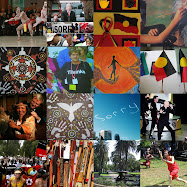 Art installation by Peter Hennessy: My Hubble (the universe turned in on itself (2010). The telescopic function is reversed and visitors are encouraged to play with, modify and create their own mini universes on the ground which are then projected into outer space.
Art installation by Peter Hennessy: My Hubble (the universe turned in on itself (2010). The telescopic function is reversed and visitors are encouraged to play with, modify and create their own mini universes on the ground which are then projected into outer space.
Saturday 31 July 2010
Cockatoo Island Part 6
 Art installation by Peter Hennessy: My Hubble (the universe turned in on itself (2010). The telescopic function is reversed and visitors are encouraged to play with, modify and create their own mini universes on the ground which are then projected into outer space.
Art installation by Peter Hennessy: My Hubble (the universe turned in on itself (2010). The telescopic function is reversed and visitors are encouraged to play with, modify and create their own mini universes on the ground which are then projected into outer space.
Friday 30 July 2010
Thursday 29 July 2010
Wednesday 28 July 2010
Cockatoo Island Part 4
Tuesday 27 July 2010
Monday 26 July 2010
Cockatoo Island Part 2
Sunday 25 July 2010
Sydney Biennale - Cockatoo Island 1

Cockatoo Island, largest island in Sydney Harbour, former colonial prison, and one of Australia's largest shipyards in the 20th century. Lots of colonial heritage building (submitted for World Heritage Listing) and more recent maritime industrial buildings. And one of the venues of art installations in the Sydney Biennale. We're going to visit over the next couple of weeks.
Wednesday 14 July 2010
Le quartorze juillet

The Sydney suburb of Matraville contains many streets named after significant locations where ANZACs fought during World War One. Anzac Parade is a major Sydney artery. It was named in 1917 to commemorate the occasion when the AIF (Australian Infantry Forces) camped at Kensington Racecourse and paraded down that road on their way to embark for overseas service. Others streets include Amiens, Ypres, Pozieres, Menin, Flanders, Amiens, Bullecourt, Bapaume, Hamel, Armentieres. The local public school is called Soldiers Settlement.
I especially like the blue plates, commemorating in French the significance of the name, and reminiscent of the street name plates of France.
From the Randwick City Council web site:
"In 1917 a gift of 72.5 acres of Crown land, described as 'the waste sand hills beyond Daceyville, was made available for returned soldiers from World War I. A Voluntary Workers Association formed and between 1918 and 1925 some 93 homes were built, south west of Anzac Parade and Beauchamp Road, as the Matraville Soldiers' Garden Village... The houses eventually passed to the State Housing Board. In 1977 despite local protests, all but one of the cottages was demolished and the site redeveloped. The surrounding streets recall battlefields and sites of World War I."
Subscribe to:
Posts (Atom)








